

![]()
Over the last hundred years, the look of the "L" has changed a lot: the stations, the urban landscape and the trains themselves. The original wooden cars started out in liveries (paint schemes) that resembled the main line passenger cars of the day. But, over the decades, they changed with the times. After the CTA took over, the number of different schemes increased as each new series of cars was usually delivered in a new style and all of the old cars were repainted to resemble them.
Below are charts, diagrams and drawings depicting
all the "L" liveries on all the different types of cars, including
the newest that the CTA is beginning to phase in.
Delivery to 1924 Delivery to 1924 1992-present 1924 to 1939 1924 to 1939 1939 to 1957 1939 to 1951 Delivery to 1955 1947 to 19?? 1955 to 1974 Delivery to 1973 Delivery to 1974 1952 to Retirement 1960 to 1964 Delivery to 1964 1947 to 19?? 1971 to 1975 1965 to Retirement 1966 to 1985 Delivery to ? 1974 to ? 1972 to ? 1974 to 1976 1974 to 1976 1975 to 1976 1974 to 1976 1982? to Retirement 1985? to Retirement 1985 to Retirement 1982? to Retirement Delivery to date Delivery to date
(51-54)
Most cars (data
unclear)
Only: 4001-4250
Only: 2007-2008
(1892-1992)
All cars
All cars
All cars
All cars
Last : 5002
Only: 1812, 1814
First: 5001
Last: 51
Except: 6721-6722
Last: 6573-6574
Except: 1-4
Last: 3
All cars
Only: 6127-6130
Last: 6129-6130
Only: 1-4
Last: 1, 2
Only: 1811
Only: 53-54
First: 53
Last: 54
Except: 6453-6454
First: 6209-6210
Except: 1, 3
First: 49
Last: 2029-2030
Only: 1, 24
Last: 24
Except: 2029-2030
First: 2053-2054
Only: Select cars,
see list below
First: '75 (52)
Only: Select cars,
see list below
First: 6711-6712
Only: Select cars,
see list below
First: 27
Only: Select cars,
see list below
First: 1776
All cars
Select cars
Only: 5-50
All cars
All cars
All cars
Pullman Green and Other Early Liveries
Attempting to catalogue all of the "L" paint schemes in its 100-plus year history is difficult, given that for all intents and purposes the large-scale use of color film did not come about until the 1935 creation of Kodachrome. However, paint chip analysis, manufacturers' records and newspaper archives can fill in at least some of the blanks. Accounts indicate that the Northwestern, Metropolitan and South Side lines all painted their rolling stock Pullman Green, a dark shade of green that was standard to Pullman Sleeping Cars, at one time or another. The only exception seems to have been the Lake Street, who liveried their original cars in Tuscan red. The cars also had lettering, numbering and details painted in gold or white paint, the elaborateness varying from company to company and series to series. Roofs seem to have been gray, although the South Side Rapid Transit seems to have at one point used a mauve/salmon-colored roof. There is also some data indicating that one of the properties used blue and another yellow at some point in time, but information there is vague at best.
The first 4000s delivered in 1913-14 seem to have carried on this scheme, liveried in Pullman Green with gold or imitation gold lettering. These cars were split up evenly among the "L" companies (except the Chicago & Oak Park [former Lake Street], due to their financial insolvency and need for the cars to be equipped with trolley poles, which they couldn't) and were lettered for their assigned company.
In 1992, to celebrate the "L"'s centennial, the CTA prepared a project, led by Bruce Nelson, to apply S.S.R.T. type colors and graphics to a 1964 Pullman 2000-series car. Although these cars obviously never originally carried this scheme, the car (2007-2008) emerged as Heritage Cars 1892-1992. They toured the Loop for the centennial celebration, then served as a customer service train. The cars were retired last year and bought by a private citizen, who has discussed restoring the car to a more appropriate livery.
Salmon, Orange and Green
When the second generation 4000s (4251-4455) arrived in 1922-24, they were liveried in a new scheme unique to the 4000s: a salmon roof, green body and burnt orange through the windows. Evidence suggests that the rest of 4000s were repainted in this scheme, as were the system's wooden cars. The scheme lasted from 1924 to 1940.
Chicago Rapid Transit
In the late 1930s, the Chicago Rapid Transit Company, now owner of the entire "L" system, decided to adopt a new color scheme, consistent for all rolling stock. The car body would be brindle brown, with burnt orange through the windows. The roof remained gray. Wooden stock first adopted this scheme in 1939; the 4000s began to sport it in 1940. Some cars bore the words RAPID TRANSIT on the letter board, others did not.
The wooden stock, destined to be retired by the CTA as soon as possible, were never repainted and lived out their lives in this scheme. The 4000s also bore the design well into the CTA's reign, though they were eventually repainted. In the meantime, the CTA simply added their early red disc herald to the sides of the cars.
5000-series Natural Aluminum
When the 5000s were delivered in 1947-48, they sported their own unique, distinctive paint scheme that has never been seen on any other type of car. The sides and roof were left natural aluminum and given red highlights. A band of charcoal gray accented the windows on the sides with a border of red stripes, supplemented by a smaller red belt rail a few inches below the windows. The end window panels were red. The words CHICAGO RAPID TRANSIT COMPANY were stenciled in red above the windows and the car numbers were in red below the second to last window on each side of the #1 end of each car. After the CTA took over, they added their own herald to the sides, making the car lettered for both it current and previous owners.
This scheme lasted only until 1955, when all for cars were relivered in the mercury green, croydon cream and swamp holly orange scheme that was beginning to dominate the "L". Car 5001 (51) was restored to its original scheme in 1985 for a CERA fantrip just before retirement and the unit now resides in this scheme at the Fox River Trolley Museum, where it is the only 5000-series car available for rides.
Mercury Green, Croydon Cream, Swamp Holly Orange
This is the classic scheme by which generations of Chicagoans recognize the "L". First introduced on CSL streetcars in the 1940s and first applied to the "L" experimentally on wooden cars 1812 and 1814 in the late-1940s, this scheme was popularized by its application to all 770 PCC 6000-series and 1-50 series cars starting in 1950. The scheme is both attractive and timeless: mercury green below the windows, croydon cream through the windows with a green stripe above through the standee-windows, cream roof and a swamp holly orange belt rail below the windows.
This scheme had several variations through the years. In the first (described above) which was the delivery scheme on the first cars (6001-6130), the standee-windows stripe and the belt rail had a 1" dark green border. On the first four cars (6001-6004), the green stripe above the windows stopped in rounded ends at the front and back end of the each car; they were not carried through the front or back. This was eliminated shortly after delivery. In the second version (6001-6130), the standee-window stripe was carried through the front and back. The front door was green, except for a small portion at the top above the standee-window belt. The roof originally retained the cream color, but was repainted mercury green shortly after the delivery of 6131-6470. The last version was first applied in 1955-56. Now the standee-window bands and all of the dark green border stripes were gone, the front door was all green and a new CTA herald was applied, with the METROPOLITAN TRANSIT banner. (When the CTA first added METROPOLITAN TRANSIT to the logo, it was just an applique pasted over the top of the ball. There's a company shot of a big Twin bus at North Park Garage, with the METROPOLITAN TRANSIT at a jaunty angle!) The last cars repainted were 6093-6094 in 1960. This scheme was also applied to the 5000-series cars in 1955 and the 1-50 series upon delivery in 1959-60.
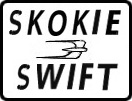 5000-series
and 1-50
series cars assigned to Skokie Swift
service were given a variant of the scheme. It was the same, except
the front bore a Skokie Swift logo (a little Swift "bird" and the
words SKOKIE
SWIFT, seen at right) and the
5000s
said SKOKIE
SWIFT on the side in red.
5000-series
and 1-50
series cars assigned to Skokie Swift
service were given a variant of the scheme. It was the same, except
the front bore a Skokie Swift logo (a little Swift "bird" and the
words SKOKIE
SWIFT, seen at right) and the
5000s
said SKOKIE
SWIFT on the side in red.
Late in the history of the this scheme, probably around 1961, it seems the CTA may have started replacing the Croydon Cream with a slightly brighter and yellower color, possibly Primrose. The idea was that it would be less vulnerable to fading than Croydon Cream. Some 6000s did appear with Primrose upper sides, but the green/cream/orange livery was superseded by Mint Green and Alpine White before the repainting of the 6000s had progressed very far.
Despite all of these seemingly complex variations, the scheme remained generally the same. Its application to such a large portion of the CTA's fleet (over three-quarters) has ingrained it into the memories of generations of Chicagoans. The cars' repainting in 1965 was met with a great deal of sorrow.
In a push for preservation, cars 6101-6102 were restored to their original scheme circa 1981 under General Operations Manager Harold H. Geissenheimer. The cars served on the Ravenswood Line for some time, then were retired for work service and for charter. The cars were also used as part of the 75th birthday celebration for former-CTA Executive Director George Krambles. The cars now reside, brilliantly restored, at the Fox River Trolley Museum.
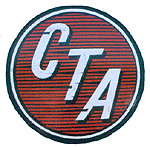
CTA Logo #1, 1947-1954? |
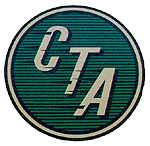
CTA Logo #2, 1954?-1956 |
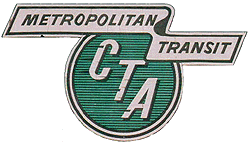
CTA Logo #3, 1956-1970s |
Green and Cream: The 4000s Last Hurrah
In 1952, the 4000s were given a facelift by way of a new paint scheme that would allow it to harmonize better with the CTA's fleet. Their new scheme was similar to the mercury green, croydon cream and swamp holly orange scheme that was being applied to the 6000s (and eventually the 5000s and 1-50s), but instead used a darker shade of green below the windows, a more yellowish cream through the windows, left off the belt rail and had a gray roof. Why they were given this scheme and not the same one as the PCCs is uncertain, though in truth there was no chance of the 4000s and the PCCs ever being paired in revenue service since their systems were incompatible.
This scheme remained until the last cars' retirement in 1973. Several cars are preserved in this scheme at the Fox River Trolley Museum and the Illinois Railway Museum, among others.
Luxury Maroon and Silver Gray
In 1960, eight PCC cars received this unusual, distinctive paint scheme. These cars (6127-6130 and 1-4) were exceptional from the start: they were equipped with high-performance General Electric control and motors and were modified to improve acceleration and top speeds. When 1-4 were delivered in 1960, 6127-6130 reentered testing and were relivered in this scheme.
The sides were painted Luxury Maroon below the windows and silver gray above. The roof and belt rail were tangerine. Perhaps most distinctive was the streamlined airflow "arrows" on the sides. Gray with a tangerine arrow and black border, the arrows at the ends were connected by a gray line near the floorline.
The scheme lasted only four years, removed when the testing program ended in 1964. In 1963, 1-4 were repainted in the final mercury green/croydon cream scheme; in 1964, 6127-6130 were also returned to their original livery.
Mint Green and Alpine White
Like always seems to happen, when the new 2000s arrived from Pullman Standard in 1964, they sported yet another paint scheme. And, of course, since the CTA likes all of its fleet to look the same (not necessarily a bad thing), they had to start repainting everything.
The scheme was simple: Mint green below the belt and alpine white above, including the roof. The two-tone scheme carried through the front in the same proportions. A CTA herald topped off the sides, under the destination sign.
The next year, the CTA began to repaint the 6000-series in the green and white scheme. In '66, it became the 1-50s turn. Finally, in 1971, two of the four 5000-series cars (53 and 54) were relivered. For about two decades after its introduction, this scheme became the dominant scheme on the "L". This was intended to stay the new scheme for the CTA, but then a new development came up...
Platinum and Black
In 1969, Budd delivered the 2200-series cars in conjunction with the opening of Dan Ryan Line. These cars, unlike all those before (and most after), did not require a coating of protective enamel (e.g. a paint scheme) and were left natural stainless steel. While this was fine and well for the 2200s, they were going to be paired with the livered-2000s regularly in Lake-Dan Ryan service, which would make for an unusual, unattractive train. So, Sundberg-Ferar conceived of a new platinum and black paint scheme for the 2000s so they would mix more gracefully. The entire body and roof would be platinum silver and the windows would be in a band of black, thus de-emphasizing their different window heights.
CTA began applying this scheme to the 2000s in 1972 and finished in 1974. That year, they applied it to two 1-50 series units as well, on an experimental basis. The scheme was the same, except for one addition: an international orange belt rail beneath the windows all the way around. These also bore the same Skokie Swift logo as before, since they were permanently assigned to that route. This scheme was only applied to cars 1 and 24. However, only car 24 actually ran on the "L" with those colors. Car 1 was painted in the platinum, charcoal and orange paint scheme, but it was shipped immediately to General Electric in Erie, Pennsylvania to be a test bed for rapid transit control packages.
Car 24 got those colors as part of the repairs to damage sustained in an accident at the Dempster/Skokie terminal. It was reintroduced into service around February of 1974. It ran for some time in those colors, with the orange stripe progressively fading at the "wear points" on the belt rail as time marched on.
Bicentennial Scheme
In 1974, the CTA began a program to redecorate a representative number of "L" cars in a patriotic red, white and blue scheme. Most of the units were also given names of Revolutionary War figures, though the kept their original cars numbers (the exceptions being the first units repainted, 2175-2176, became 1776 [both cars], and the first 5000-series car, 52, became '75). Famous patriots like George Washington (cars 6711-6712), Patrick Henry (cars 6473-6474) and Thomas Jefferson (car 6185-6186) were joined by some lesser-known figures like Haym Salomon (cars 6017-6018), Caesar Rodney (cars 2113-2114) and Francisco de Miranda (cars 6663-6664). In conjunction, the CTA public relations office produced a series of press releases on the cars and their namesakes.
Generally speaking, the cars were painted platinum silver all over, with a charcoal band through the windows in a uniform height (thus de-emphasizing the varying window heights in the different series). A large red, white and blue stripe ran along the bottom of the sides, sweeping up to the roof at the end of each double-ended unit. (The exception being the single unit 1-50s, were the stripe turned upward at only one end of the unit - next to the motorman's cab - and ended mid-roof.) Under the window closest to the front end of each car was an emblem giving the "name" of each car on a banner surrounded by a circle of red stars. The front of each car was painted red around the left window and blue around the right, with gray below and a white door in the middle. A banner with the car's name with a star on each side was placed below the window on the front door. The vast majority of cars thus painted were of the 6000-series, though a number of 2000, 1-50 and all of the 5000s were also relivered. Four pieces of work equipment were also painted in the bicentennial scheme.
As an interesting aside, when 2175-2176 were released from Skokie as 1776 the cars were to take several trips around the Loop on the Loop Shuttle service to show off their new livery. The keen-eyed observed noted that the ACI stripe on the front door panel was temporarily covered over, so that Tower 12 wouldn't send the train south on the Dan Ryan that day, where it was normally assigned. The cover was removed before the train left the Loop that day.
A few abberations emerged in the last year of the Bicentennial scheme. Car 51 was the last 5000-series car painted into the Bicentennail scheme. The unit was out of service at Skokie Shops in late 1976 and by the bitter end of the year (December 27th, to be precise) it was taken apart inside the shop and was being worked on. By July 11, 1977, it's rebuilding was complete (including its new tan and chocolate interior), and it was given the full Bicentennial paint scheme... after the nation's Bicentennial had passed! In a variation of the scheme, it was not given a colonial-era 'name' as the other Bicentennials were; its name banners simply read "Skokie Swift" (possibly due to the after-the-fact application of the scheme).
A similar abberation occurred when another set of 2000s was given the Bicentennial scheme and names "Oak Park-All American City" instead of a Colonial personality. Around that time, the city of Oak Park was on the CTA's case about car appearance, service, et cetera on the West-South Line. So, as an appeasment to the city, they got their own car! (Relations between the City of Chicago and the suburbs was tenuous during the Byrne administration... or at other times being downright nasty.) The name "Oak Park-All American City" arranged on two lines within the name banner. As of August 10, 1976, the cars were back on the West-South, so they were probably released from the shops with their new paint scheme within the preceding week, at most.
The bicentennial scheme was never meant to become the official paint scheme for all "L" cars, just a special recognition of the country's 200th birthday, temporary applied to selective cars. It was eventually removed from all the cars, though a modified version of it did become of dominant scheme on the "L" for the follow two decades.
Bicentennial Logo #1 Bicentennial Logo #2 Bicentennial Logo #3
Source: CERA Bulletin 115, page
118
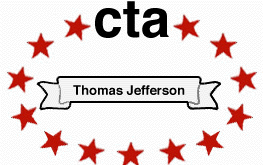
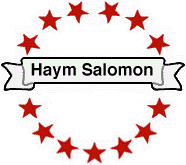
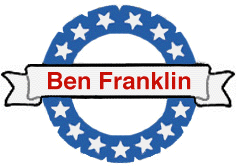
Red, White and Blue: The Spirit of Chicago!
The CTA and the riding public liked the new patriotic look of the "L", but the bicentennial scheme clearly was inappropriate for continued widespread use, as it was a complex scheme to apply and it was, by design, only appropriate for a short period around 1976. So, a new, more restrained version was created and adopted for use on all rapid transit cars except the 2200s, which were designed to be left unpainted aluminum.
The 2400-series cars arrived from Boeing-Vertol with the first version of this scheme. The ends were painted similarly to the bicentennials, with red surrounding the left window and blue the right, with a white door and gray surrounding. The sides were gray on the bottom and charcoal through the windows, again to draw attention away from the varying window heights in the different car classes. The red, white and blue stripe was retained, but made narrower and now just below the windows instead of along the bottom. Like the bicentennials, the stripe turned upward toward the roof at the ends of the double-car unit, but here it was in a sharp 90 degree turn instead of the softer angle of the bicentennials. The doors did not carry the scheme through, instead left their natural aluminum. A variation of the scheme was applied to the 2000s, except that the stripe was narrower and just under the windows instead of along the bottom and didn't sweep up. (A similar variation was later applied to the 2600-series.) These cars lacked a CTA herald or logo for the first time since the agency took over operations in 1947.
 When
the 2600-series
arrived from Budd/Transit America, they carried a similar but
slightly tweaked version of this scheme. The
gray/charcoal/red-white-blue stripe scheme was retained, with similar
proportions to the 2400s.
However, the longitudinal stripe was thinner (like on the
2000s)
and, instead of cutting upward at the ends of the car, continued
through the front and formed a belt all the way around. The charcoal
above the stripe and gray below from the sides was carried through to
the front, replacing the large panels of red and blue that had marked
"L" cars since 1974. And, for the first time, the CTA herald was
replaced by a new logo: a red, white and blue "C" with four white
stars with the motto, "I Will/The Spirit of Chicago" inside (seen
at right) . This emblem was placed under the last window on the
#1 (outer) end of each car. These cars changed little over the
following decade and a half, except that the car numbers were
originally on decals on the windows, but were later moved next to the
doors.
When
the 2600-series
arrived from Budd/Transit America, they carried a similar but
slightly tweaked version of this scheme. The
gray/charcoal/red-white-blue stripe scheme was retained, with similar
proportions to the 2400s.
However, the longitudinal stripe was thinner (like on the
2000s)
and, instead of cutting upward at the ends of the car, continued
through the front and formed a belt all the way around. The charcoal
above the stripe and gray below from the sides was carried through to
the front, replacing the large panels of red and blue that had marked
"L" cars since 1974. And, for the first time, the CTA herald was
replaced by a new logo: a red, white and blue "C" with four white
stars with the motto, "I Will/The Spirit of Chicago" inside (seen
at right) . This emblem was placed under the last window on the
#1 (outer) end of each car. These cars changed little over the
following decade and a half, except that the car numbers were
originally on decals on the windows, but were later moved next to the
doors.
Around this time, the 2400s were modified to more closely resemble the 2600-series paint scheme. The stripe was narrowed and lifted to just under the windows, as had been done on the 2000s. By early 1994, none of the 2400s has the original full striping. Later, the charcoal through the windows was removed and, with the exception of the red, white and blue stripe, the sides were left finished aluminum.
The 6000s
and 1-50s
were the last cars repainted in this scheme. Their general shape was
similar to the 2600s
and many of these cars were relivered in the 2600-series
scheme with the longitudinal stripe and charcoal window band (though
some 6000s
did receive the scheme similar to the 2000s,
with the red and blue window surrounds on the front end). The
1-50s
received the scheme in 1985 as part of a general overhaul by the
Morrison-Knudsen Company that also included overhauled trucks, power
and ventilation 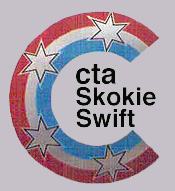 systems,
interiors and pantographs (on Skokie cars). With cars 1-4 retired,
they reentered service as the 5-50
series.
systems,
interiors and pantographs (on Skokie cars). With cars 1-4 retired,
they reentered service as the 5-50
series.
The Skokie 5-50s and 51-54 (all of which were assigned to the Skokie route) had a modified "I Will/The Spirit of Chicago" logo, with had the same shape, only the words were replaced with "cta/Skokie Swift" (logo seen at right) .
Natural Aluminum: The Future of the CTA
As described above, the 1969 delivery of the 2200-series Budd cars introduced a new element into the CTA's fleet of cars: unpainted stainless steel sides. Because they were never meant to be covered with a coat of protective enamel, the 2200s have borne no paint scheme since they arrived on CTA property. They were the only cars to do so until the delivery of the first 3200-series cars in 1993, built by the Morrison-Knudsen Company. Though of a different design, these cars also had unpainted stainless steel sides, corrugated to discourage graffiti. The CTA now had two classes of cars that were undecorated metal, though their assignment to different lines currently precludes them from being operated together in normal revenue service. But, the CTA has apparently decided that this should be the new look of the "L" and a number of 2600-series cars have begun to appear striped of their window bands and longitudinal stripes. The sides of these are left stainless steel, decorated only with the car number in black next to the doors and the CTA logo in black below the first window on the #1 end of each car. The molded fiberglass fronts are painted gray to match the sides. This scheme for the 2600s will one day dominate the "L" when all 598 units are finished being refurbished in about 3-4 years; right now these cars are still very much in the minority of the 598 2600-series cars. No other series has been relivered in this fashion as of yet.
One exception is the twenty-two 2400-series work cars. These cars have also been striped of paint and decals, with the sides left natural aluminum and the fronts painted gray. However, unlike the 2600s, the work motor-capable 2400s have diagonal red stripes below the windows on the front and a red-white-red longitudinal stripe along the side, both reflective, denoting its work-car status.
Mock-Ups and Proposed & Experimental Paint Schemes
Every time the CTA considers a new paint scheme for its "L" cars, a number of tests and experiments are done before a satisfactory look is achieved. Sometimes out-of-service cars are used as guinea pigs; sometimes in-service cars get temporary, one-of-a-kind paint jobs. Sometimes mockups are done temporarily using construction paper and other materials. Many of these liveries never see the light of day; others transform into the schemes that we all know and remember.
One well-known paint scheme that was first applied experimentally on the "L" at first was the famous Mercury Green, Croyden Cream and Swamp Holly Orange scheme. Although popularized by its use on all 770 6000- and 1-50 series PCC cars (as well as on the PCC streetcars), the scheme was also applied on the "L" to wooden cars 1812 and 1814. Cars 1812 and 1814, which started their lives as Northwestern Elevated trailers 273 and 276 (later 1273 and 1276), respectively, were rebuilt along with six other units, by the CTA into motor cars 1812 and 1814 and given this scheme. Although it was modified slightly to fit with the car's architecture, it was essentially the same scheme applied to the 6000s and 1-50s. The cars ran extensively on the Lake Street Line in its later years and was retired from revenue service in the late 1950s. No other wooden cars received the Mercury Green, Croyden Cream and Swamp Holly Orange scheme. Car 1811, which was been upgraded in the same group from Northwestern car 1272, received an evergreen green and white scheme, a harbinger of things to come some 15 years later with the 2000-series' Mint Green and Alpine White scheme.
A 4000-series plushie was at one point outfitted with a cream belt rail and letterboard with dark green all over the rest of the carsides. It is uncertain how the ends were handled in this experimental scheme. It ran on the North-South Route around 1953 or 1954, and the variation really stood out! No other cars were so liveried, it seems.
For a time before their delivery, it was considered giving the 2400-series cars the platinum and black scheme used on the 2000s, which had allowed them to train more gracefully with the plain stainless steel 2200-series units. A scale model of a 2400 made by Boeing and presented to CTA before production began was initially painted in this livery. It was decided before full production began, however, to go with the modified Bicentennial livery in which they were delivered.
One of the more obscure schemes was worn ever-so-briefly by car 50: the RTA blue, orange, and brown striping (like the F40s originally wore, but confined to the car's belt rail). It received this paint scheme around 1977 or so. It had a basic platinum mist body with charcoal through the windows, just like car 24 wore starting in 1974 (just without the orange belt rail). The RTA colors subbed for the red, white, and blue belt rail stripe seen in a later variation of the scheme. The RTA "ball" logos were stenciled on four of the upper sash windows (probably the ones adjacent to and inboard of the doorsets). Then-CTA Chairman James McDonough went up to see the car at Skokie Shops and summarily rejected the design. McDonough apparently didn't think the CTA should be advertising for the RTA (at the time there was some rivalry between the agencies). Interestingly, at the same time the CTA 9000-series "fishbowl" buses were getting an 18" RTA logo under the driver's window and in 1982, the 2600-series "L" cars would begin delivery with an RTA logo in the top of the side window nearest the #2 end. Car 50 was restriped without ever going into service in the RTA colors. Later on, evidence of the RTA colors came through as the red, white, and blue stripes wore and peeled.
When the Spirit of Chicago livery was being developed for the 2600s in the early 1980s, a 6000-series car was given the prototype application of the "2600-style" livery, including painting 2600-style marker lights, headlights and taillights on the car end! The car had been retired and was sitting around at Skokie Shops waiting for the end to come, so never left the property in those colors.
In the mid-1990s, there was some discussion as to what could be done to liven up the look of the "L" in general and the rolling stock in particular. One suggestion was to denote each car's line assignment in the livery colors. Car 2619 - which was assigned to the Green Line before its closure in 1994 - came back from being repaired at the Delaware Car Company and recieved green/white/green striping at the belt rail instead of the standard red/white/blue. It was decided that this would be too much trouble for the maintenance department and it too never left Skokie in that scheme.